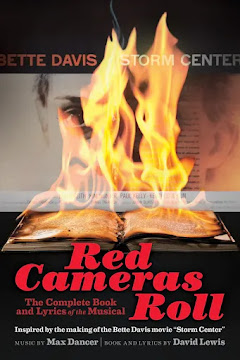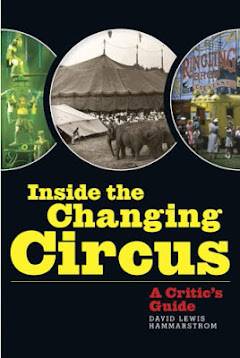In a recent post about my brief flirtation with a casting agent from NBC’s Celebrity Circus who told me that I am about the only real circus critic out there, I took gleeful flight in flaunting my agreement with the guy, Ashton Ramsey. If I lent the impression that I was dismissing serious circus scholars and critics around the world, that would not be the first time I’ve been boastful or stupid — or both.
I must say, I do not see critical circus reviews in this country — that is, outside of the occasional big city newspaper based movie, theatre or dance critic now and then filing a real review of a circus. When I looked in one issue of The White Tops, I did not see it other than, to be fair, a review by Dominique Jando of the New Pickles Traces. His was a tactfully worded critique of the show, surely as valid as the more sledgehammer approach which I have sometimes taken (ouch! My tea cup just attacked my finger...)
Raffaele De Ritis sent a fine comment explaining a very different situation in Europe where many “critics” labor to keep alive the conversation about circus art. As for the U.S., Raffaele points justly to author Ernest Albrecht. Now, notwithstanding his quarterly Spectacle (which I’ve not seen), I have tended to regard Mr. Albrecht as a very articulate advocate for what he calls “the new American circus” rather than a critic, per se. And I could be off base here. Albrecht’s book, The New American Circus, chronicles with passion and support the intricate artistic developments behind many of the changes we have lived through in the most turbulent chapter in circus history. I quote from three of its insightful interviews in my recently published Fall of the Big Top: The Vanishing American Circus. Of particular value, Albrecht’s passing along Guy Caron’s reaction to the Moscow Circus (“this is it!”) absolutely nailed my long-held perception that Cirque du Soleil sprang from Russian sawdust.
I just don’t quite agree with Albrecht’s embracement of a form of circus that, in my skeptical view, is drawing ominously closer to what I call circus ballet. Moreover, I think Mr. Albrecht nearly welcomes the demise of animals in circus. But, of course, this alternative form in which Albrecht seems to find promising value could well end up being what “circus” becomes in a future devoid of animals and human daredevils. Indeed, he addresses a sphere of evolution under big tops that is full (it would appear) of new ideas and deeper direction. And I am all for innovation.
I also quote the English scholar, Helen Stoddart, from her intellectually penetrating book, Rings of Desire, which luckily I chanced upon at the local library. Ms. Stoddart and I evidently see the essence of circus in very similar ways. That is, a very real enterprise that rides high on risk taking.
Were I a rich bon vivant and/or not so chronically adverse to air travel (blame it on a bad flight back from the Soviet Union in 1979), how I would love to hang out in Europe for a few months, taking in as many circuses as possible. What a book that might make. Does Greyhound go over there?
Anyway, here is Raffaels's mini-essay in full, well worth bringing to the forefront, for he pays tribute to many people who, as he proudly points out, do look at circus art critically. And I am all for that!
David,
few notes about living circus critics. I think that, according your experience, your knowledge of history and present, your honesty and your writings, you are surely a very important reference circus critic in the true sense of term. It is also true that, fortunately, others deserves the same status so you are not alone in your hard role.
For example, Mr. Ernest Albrecht is a very competent critic, with a solid theatre background too, editing the only real circus critic magazine in the Usa, and constantly travelling personally Europe in the major festivals and circuses.
And, even if not born in America, you have in the country Dominique Jando. By his long and unique experience, I consider him the greatest living critic and historian in the world, for circus past and present. I don't think that in America there are today circus scholar with his knowledge of the subject. Crossing the ocean, there are many other circus critics. Pascal Jacob, in France, is known worldwide in the business and is the most prolific circus writer today, having signed dozens of book for prestigious publishers in his country. Christian Hamel, in France president of Club du Cirque, is a very competent critic, widely recognized in the continent. Don Stacey in Great Britain is the world veteran of the circus critic, and David Jamieson (King Pole editor) is not les competent in his country. Artur Hofmeester in Holland signed in decades hundreds of honest critics about the most important circuses in the world.
Frederic Bollman in Switzerland is by 30 years one of the most respected circus critics in the world. Jordi Jane, in Spain, is at my knowledge the only circus critic in the world having a weekly circus column on a national daily newspaper. In Italy, Alessandro Serena teaches circus at the university of Milano and regularly debates and reviews about circus in many papers. And I permit to add myself, having signed hundreds of articles for all the majors circus magazines in the world, and of specific books . The same can be said for Julio Revolledo Cardenas in Mexico, or Mark St.Leon in Australia.
If you ever was at the Monte Carlo Circus Festival, the press office hosts yearly at least 50 circus writing specialist from all over the world.
And I think is a good thing for the circus.
Thank you, Raffaele
Subscribe to:
Post Comments (Atom)






















2 comments:
David,
Ernest Albrecht's quarterly journal is entitled "Spectacle" and not Spangles. Ernie is a professor of theater and a theater critic of long standing, his reviews of circuses here and abroad, published in "Spectacle" are insightful and thorough. I highly recommend that you take a look.
Don Covington
...is there anyway to contact Frederic Bollman?
Post a Comment